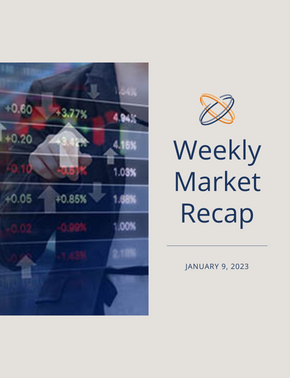Week in Review
Equity Markets:
The S&P 500 ended a skid that lasted three weeks, closing the week up 1.4%. The index flipped positive after the strong rally Friday, fueled by optimism of slowing inflation. The index spiked 2.3% on Friday after the labor market report was released prior to the market open.
This week earnings season will jump into full swing which will be led by some of the major banks. According to FactSet, analysts are expecting an earnings decline of 4.1%, which marks a large pivot from the start of Q4. On September 30th, analysts projected S&P earnings to grow by 3.5%. Only 20 S&P 500 companies have reported Q4 results and 75% have beaten earnings expectations while 65% have beaten revenue estimates.
Fixed Income Markets:
The 10-year treasury yield dropped to 3.56 %, down just over 30 basis points from the close in the previous week. Prices rallied on the slower-than-expected wage growth numbers released Friday. The meeting minutes from December’s policy meeting were released this week. The minutes continued the narrative that the Fed will remain committed to getting inflation back to its 2% target. There are mixed feelings about where the terminal rate will be, but the vast majority of Fed members believe rates will need to stay higher for longer. The Fed does not anticipate any rate cuts this year. Many market participants believe the Fed will need to cut rates sooner to ensure they do not slow the economy too much.
The yield curve remains steeply inverted with the 30-day bill yielding 4.2% and the 2-year treasury yielding 4.25%. As more components of the yield curve invert, history suggests the recessionary odds continue to rise.
Economic:
In a surprise move downward, the ISM Manufacturing PMI moved into contraction territory. The reading missed expectations of a 55 reading and dipped to 49.6. The labor market remains strong as seen by the multiple reports last week. The unemployment rate dropped to 3.5% and non-farm payrolls rose 223,000 in December, beating the estimate of 200,000. The one area that showed slowing was wage growth. In December, wages increased by 0.3% which was lower than the expected 0.4%. On annual basis, wages increased by 4.6%, slower than the forecasted 5%.
Looking Ahead
Equity Markets:
The expectations for the market have continued to soften, as seen by analysts’ earnings estimates. According to data collected by Yardeni Research, the consensus is for earnings declines in Q4 2022, Q1 2023, and Q2 2023. As expectations deteriorate, we believe it is important for investors to remain focused and committed to their long-term objectives and investment plan. It can be very easy for current sentiment to pull an investor’s attention away from their thoughtfully developed plan to meet their long-term goals.
Historically, the markets have begun their recovery prior to both the economy and market sentiment improving. We do not believe the environment is one where excessive risk should be taken, but attractive long-term opportunities can be found when the news and sentiment are at their worst. A dynamic rebalancing process is one tool to assist in removing the emotion from investing. Broad diversification is another staple that has proven to reward investors. The current environment has tailwinds that could benefit investors, unlike the previous cycle where a few select sectors, styles, and regions dominated.
Fixed Income Markets:
We believe that the bulk of the damage in the bond market occurred last year. There will be more rate hikes this year and the only debate is about the pace and the extent. Whether the Fed chooses to raise 50 basis points or 25 basis points at the next meeting appears to be a technicality in our opinion. The decision will likely have an impact on the volatility in the bond market, but we are nearing the end of the current hiking cycle. We believe the 4.25% level on the 10-year in October will mark the cycle high before rates remain rangebound in the 3% range.
Economic:
The CPI report set to be released on Thursday is the headline event for the week. With no Fed policy meeting in January, they will have two months of data in helping decide the next rate hike. The preliminary University of Michigan Consumer Sentiment Index will provide a timely view of the consumer.
Important Disclosures:
Investment Advisory Services offered through Krilogy®, an SEC Registered Investment Advisor. Please review all prospectuses and Krilogy’s Form ADV 2A carefully prior to investing. This is neither an offer to sell nor a solicitation of an offer to buy the securities described herein. An offering is made only by a prospectus to individuals who meet minimum suitability requirements.
All expressions of opinion are subject to change. This information is distributed for educational purposes only, and it is not to be construed as an offer, solicitation, recommendation, or endorsement of any particular security, products, or services.
Diversification does not eliminate the risk of market loss. Investments involve risk and unless otherwise stated, are not guaranteed. Investors should understand the risks involved of owning investments, including interest rate risk, credit risk and market risk. Investment risks include loss of principal and fluctuating value. There is no guarantee an investing strategy will be successful. Past performance is not a guarantee of future results. Indices are not available for direct investment; therefore, their performance does not reflect the expenses associated with the management of an actual portfolio. The S&P data is provided by Standard & Poor’s Index Services Group.
Services and products offered through Krilogy® are not insured and may lose value. Be sure to first consult with a qualified financial advisor and/or tax professional before implementing any strategy discussed herein.














